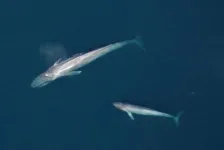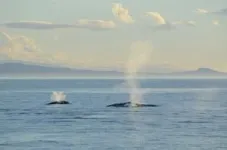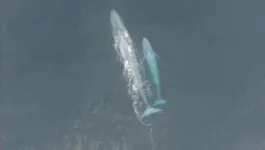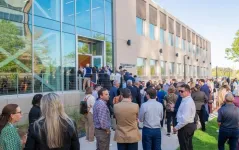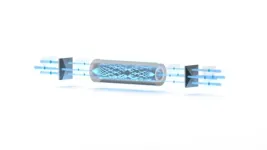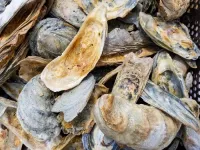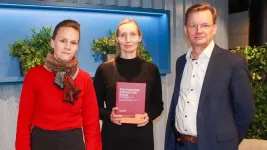(Press-News.org) Only two blue whale births have ever been recorded in human history, both decades ago. This remains an extraordinary mystery given there used to be hundreds of thousands of blue whales before whaling started — even today blue whales number around 10,000 to 25,000 — and they give birth every two to three years.
Not only are births very stealthy, but calves are also only rarely sighted — far less than would be expected from their pregnancy rates. Calves closely follow their moms and are sighted as mother-calf pairs, but why are so few detected?
A new University of Washington study, published Feb. 20 in Endangered Species Research, proposes why. Its explanation hints at when and where the unseen births are happening and where blue whale calves spend their earliest months. The findings offer some hope for the health of the population.
Trevor Branch, a UW professor of aquatic and fishery sciences who studies blue whales, set out to unravel this mystery by looking at a range of hypotheses. He proposes that one in particular is the best explanation: It’s mostly because researchers prefer summertime research on feeding congregations of blue whales, but calves are born in fall and winter, and are weaned before they return to feeding areas.
In summer, blue whales migrate to feed in colder regions where krill is plentiful: for example, off California. In winter, when ready to give birth, they return to warmer regions like the Gulf of California and the eastern tropical Pacific. Around seven months after being born, and already at a whopping 52 feet (16 meters) long, the calves are weaned and stop associating with their mothers.
But across various blue whale populations, high pregnancy rates of 33-50% annually seem to contradict the average 3.1% rate of sightings of blue whales involving mother-calf pairs.
When compared with other hypotheses to explain the mystery of why so few calves are observed, such as low fetal survival, low calf survival, low birth rates, or calf separation from mother, Branch discovered that the timing hypothesis best explained observed patterns.
“My conceptual model can explain the mystery of the missing calves: Blue whales produce calves, or give birth, shortly after departing their summer feeding grounds, and wean their calves seven months later, just before they return”, Branch said.
This would explain why researchers – most of whom conduct blue whale field studies in summer months – seldom sight mothers with calves.
Branch compiled data from long-term field studies and combined this with biological information from historical whaling records to come up with this hypothesis, finding higher proportions of calves in winter regions, and lower proportions in summer regions. He is now coordinating a large collaboration to test the idea with field data by month in each region, combined with estimates of the size of calves by month.
One concern about low calf sighting rates was that this might be a warning signal of low birth rates or low survival of calves. Instead, the new hypothesis offers up some hope that higher number of calves could be sighted from field studies concentrated in regions that blue whales travel to in winter and spring.
"This new idea provides an alternative explanation for why some blue whale populations appear to produce very few calves: It's not a failure of calf production, it's because fieldwork in those populations is understandably concentrated in easily accessible summer feeding areas," Branch said.
The research was funded in part by the International Whaling Commission’s Southern Ocean Research Partnership.
For more information, contact Trevor Branch at tbranch@uw.edu.
END
Unraveling the mystery of the missing blue whale calves
2025-02-21
ELSE PRESS RELEASES FROM THIS DATE:
UTA partnership boosts biomanufacturing in North Texas
2025-02-21
The University of Texas at Arlington is joining forces with the Texas A&M Engineering Experiment Station (TEES) to operate the new National Center for Therapeutics Manufacturing Satellite Campus at Pegasus Park (NCTM2) in Dallas.
UTA’s Institute of Biomanufacturing and Precision Medicine (IMPRINT) is partnering with TEES on NCTM2, an extension of the National Center for Therapeutics Manufacturing (NCTM) in College Station. The collaboration will expand UTA’s biomanufacturing capabilities and provide NCTM2 with access to financial ...
Kennesaw State researcher earns American Heart Association award for innovative study on heart disease diagnostics
2025-02-21
Kennesaw State University researcher Chen Zhao has earned the 2025 American Heart Association Institutional Research Enhancement Award (AIREA) for his unique research on non-invasive blood flow prediction in cardiovascular disease diagnosis.
The $194,032 award will allow Zhao to continue developing technology aimed at evaluating Fractional Flow Reserve (FFR), a measurement used to diagnose coronary artery disease (CAD). According to the Centers for Disease Control and Prevention, CAD is the leading cause of death in the United States, with an average of 375,000 to ...
Self-imaging of structured light in new dimensions
2025-02-21
Researchers of photonics from Tampere University, Finland, and Kastler-Brossel Laboratory, France, have demonstrated how self-imaging of light, a phenomenon known for nearly two centuries, can be applied to cylindrical systems, facilitating unprecedented control of light’s structure with great potential for advanced optical communication systems. In addition, a new type of space-time duality is explored for powerful analogies bridging different fields of optics.
In 1836, Henry F. Talbot performed an experiment, where ...
Study highlights successes of Virginia’s oyster restoration efforts
2025-02-21
Virginia has made significant investments in the restoration of oyster reefs in the Chesapeake Bay, and now a study led by William & Mary’s Batten School & VIMS suggests those management practices are literally paying off in the Rappahannock River. The study, recently published in the Journal of Environmental Management, was led by Batten School of Coastal & Marine Sciences Ph.D. student Alexandria Marquardt, who presented the results to the Virginia Marine Resources Commission’s (VMRC) Shellfish Management Advisory Committee ...
Optimism can encourage healthy habits
2025-02-21
Do you see the glass as half empty or half full? If you rewind to the start of the COVID-19 pandemic, chances are you experienced some level of pessimism. And who could blame you? With social isolation, health concerns and economic uncertainty, fear and anxiety became a daily reality for many.
A team of researchers from Syracuse University and Michigan State University recently explored the personal characteristics that help people handle prolonged stressors, such as the pandemic. Led by Jeewon Oh, assistant professor of psychology in Syracuse University’s College ...
Precision therapy with microbubbles
2025-02-21
The targeted treatment of brain diseases such as Alzheimer’s, Parkinson’s or brain tumours is challenging because the brain is a particularly sensitive organ that is well protected. That’s why researchers are working on ways of delivering drugs to the brain precisely, via the bloodstream. The aim is to overcome the blood-brain barrier which normally only allows certain nutrients and oxygen to pass through.
Microbubbles that react to ultrasound are a particularly promising method for this sort of ...
LLM-based web application scanner recognizes tasks and workflows
2025-02-21
A new automated web application scanner autonomously understands and executes tasks and workflows on web applications. The tool named YuraScanner harnesses the world knowledge stored in Large Language Models (LLMs) to navigate through web applications in the same way a human user would. It is capable of working through tasks in a coherent fashion, performing the correct sequence of steps as required by, for example, an online shop. YuraScanner was tested against 20 web applications, unearthing 12 zero-day cross-site scripting (XSS) vulnerabilities. The technique behind YuraScanner as well as the tool itself have been developed by researchers ...
Pattern of compounds in blood may indicate severity of gestational hypertension and preeclampsia
2025-02-21
Preeclampsia, a complication of pregnancy characterized by high blood pressure and high levels of protein in the urine (proteinuria), indicating damage to the kidneys or other organ damage, is the main cause of maternal-fetal death in Brazil and the runner-up worldwide. In a Brazilian study published in the journal PLOS ONE, the pattern of substances present in patient blood samples varied according to the severity of the preeclampsia concerned.
The findings from the study, which was supported by FAPESP, ...
How does innovation policy respond to the challenges of a changing world?
2025-02-21
Researchers from the University of Vaasa, Finland, and Kent Business School, UK, have gathered insights on innovation policy, its current status and future perspectives in their new book “The Evolving Innovation Space”. The book offers research-based insights on how innovation can best be used to drive economic change and to find solutions to global problems.
– In a changing world, where geopolitical tensions are rising and artificial intelligence is gaining ground, innovation policy must also be reconsidered from new perspectives, says Helka Kalliomäki, one of the editors.
With digital ...
What happens when a diet targets ultra-processed foods?
2025-02-21
Most dietary programs are designed to help people achieve weight loss or adhere to U.S. nutrition guidelines, which currently make no mention of ultra-processed foods (UPFs). UPFs – like chips or candy – are the mass-produced, packaged products that contain little or no naturally occurring foods. Eating UPFs is strongly associated with increased risk of diseases and early death.
Because almost no existing programs focus specifically on reducing UPF intake, researchers from Drexel University’s College of Arts and Sciences designed an intervention that included a variety of tactics to target the uniquely problematic ...
